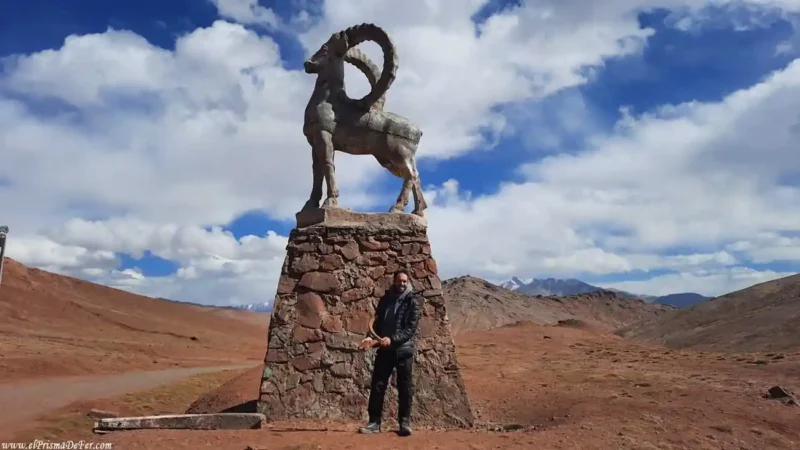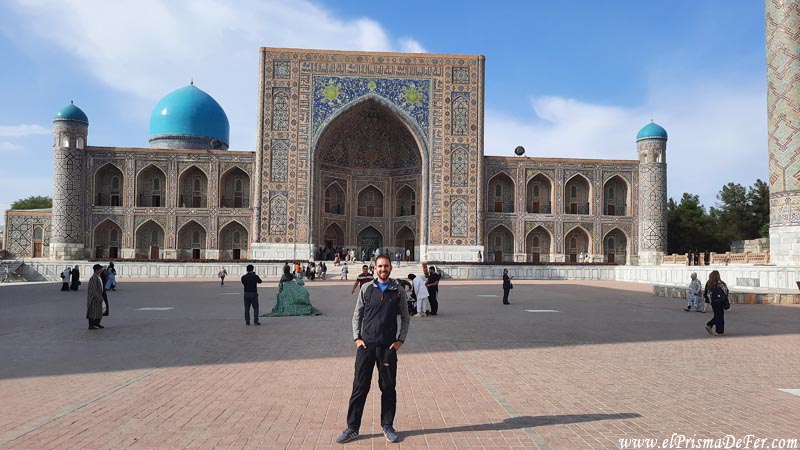Tajikistan is a country that, due to its strategic location in the heart of Central Asia, shares borders with five countries: Kyrgyzstan, Uzbekistan, Afghanistan, China and a small portion with Pakistan (although not transitable). The purpose of this guide is to share the most useful and up-to-date information on how to cross the main border crossings, their specific features, their passability, and what to keep in mind depending on the neighboring country.
During my trip through Central Asia and the mythical Silk Road, I entered Tajikistan from the border crossing with Kyrgyzstan, through the Kyzyl-Art pass, and then left through the crossing it shares with Uzbekistan, between Panjakent and Samarkand.
But I also did a fair amount of research on the other options available. For travelers traveling overland, knowing where to enter and exit is key, as not all border crossings are open to international tourism or in optimal conditions. In Tajikistan, crossing a border can be as much a part of the adventure as the destination itself.


Table of Contents
🇰🇬 How to cross the border between Kyrgyzstan and Tajikistan: Bor-Dobo / Kyzyl-Art crossing
One of the most frequently used crossings by those travelling on the Pamir Highway, especially if entering from Kyrgyzstan, is the pass between Bor-Dobo (Kyrgyzstan) and Kyzyl-Art (Tajikistan), at 4,280 meters above sea level.
What do I need to keep in mind when crossing the border from Kyrgyzstan to Tajikistan via the Kyzyl-Art crossing?
📄 Mandatory permissions
- GBAO Permit (Gorno‑Badakhshan Autonomous Oblast):
- Mandatory for entering the Pamir Autonomous Region in Tajikistan, even if you are crossing from Kyrgyzstan.
- It can be obtained online along with the e-visa or at OVIR offices in Tajikistan (Dushanbe, Khorog, Murghab).
- Permiso de zona fronteriza de Kirguistán:
- The crossing area is considered a sensitive zone. Travelers must obtain a border‑zone permit issued by the Ministry of Tourism or local agencies.
- It is recommended to process it in advance (30–45USD), since without it you are not allowed to cross.
🚧 Protocol at the crossing
- Desde la parte kirguisa (Bor‑Dobo):
- Presentás pasaporte, visa si corresponde, los documentos del coche (si viajás en auto), y el border permit de Kirguistán.
- Se realiza el sellado y se cruza a la zona neutral
- En la parte tayika (Kyzyl‑Art):
- Te revisan pasaporte, visa/turista y el permiso GBAO. Si viajás en auto, revisan también los papeles del vehículo.
- El procedimiento suele durar entre 15 y 30 minutos si todo está en regla
⚠️ Risks and advice
- The crossing is only open to foreigners (not to citizens of Kyrgyzstan or Tajikistan).
- It is essential to obtain both permits before arriving to avoid being stranded in “no man’s land” between the gates.
- If traveling by car, many travelers choose to pay a local agency (e.g., “Destination Pamir,” “Pamir Tours”) $15–25 per person to arrange permits and coordinate transportation.
My personal experience crossing the Kyzyl-Art border crossing
After traveling through Kyrgyzstan for a month, it was time to cross into Tajikistan from the Kyzyl-Art crossing. First, I passed through the Kyrgyz city of Osh, and from there I contacted the Destination Pamir agency via WhatsApp. I spoke directly with Erali, who was in charge of managing both permits: the one for the Kyrgyz side and the GBAO for Tajikistan.
- In just 3 days, he sent me the permits via WhatsApp, ready to print or show on my phone.
- Communication was prompt, in English, clear and professional.
- I paid (in cash) his brother who works at a lodging in the village of Murghab (Tajikistan), so he had already crossed the border and checked that all the permits were in order.
- I recommend Destination Pamir for its reliability and efficiency, ideal for those who want to avoid complicated or slow procedures.
In the Guide to visit the Pamir Highway and the Wakhan Valley on your own, I tell you how to cross this border without hiring a tour or paying for a private taxi.

🌄 The “No Man’s Land” between Kyrgyzstan and Tajikistan
Once you pass the Bor-Dobo border crossing in Kyrgyzstan, you don't immediately enter Tajikistan. Between that point and the Tajik control of Kyzyl-Art, there is a strip of approximately 20 to 25 kilometers that is known as “no man’s land”. It's literally no man's land: a completely desolate landscape, with no coverage, no shelter, no services of any kind, and in many cases, not even a cell phone signal.

There is nothing. Solo vos, la montaña, el viento (frío incluso en verano) y una sensación brutal de aislamiento. No es una caminata recomendable para hacer a pie ni por aventura ni por ahorrar.
It is very important that you have assured a transport to cross it. Ya sea un taxi que los espere de un lado al otro, o arreglar con alguien de antemano. No es un tramo que convenga hacer caminando, especialmente en días de calor.
Como anécdota, cuando crucé esta frontera, lo hice en un auto con unos chicos de Bélgica que habían alquilado un auto. Me levantaron haciendo autostop cerca de Sary-Tash. On the way we crossed with a young Croatian who was doing the “ no Man’s Land ” on foot, loading a large backpack and without a stabbing. El pibe no daba más, estaba agotado y prácticamente rogaba por ayuda. Por suerte los chicos se apiadaron y lo levantaron también, aunque ya no entraba más gente en el auto. That gives you an idea of how extreme this section can be if you are not prepared.
On top of that, the Croatian didn't have a GBAO permit. The soldiers at the Tajik border didn't want to let him advance, but when they saw that he also had no way back, and after a few phone calls, they let him through on the condition that he apply for it in Murghab and then send it to them via WhatsApp.

🇺🇿 How to cross the border between Tajikistan and Uzbekistan
It's the easiest and most frequently used border crossing for those who connect Tajikistan with Uzbekistan. Since 2018, relations between the two countries have improved significantly, and border crossings are open and easy.
The most commonly used steps are:
Panjakent – Samarkand crossing
This pass directly connects Panjakent (Tajikistan) with Samarkand (Uzbekistan), and is ideal for those visiting the Fann Mountains or coming from northern Tajikistan.
- From Panjakent, there are shared taxis that take you to the border crossing (taxis stop near the market).
- The crossing is done on foot, the process is simple and quick (normally 10–30 minutes).
- On the Uzbek side, there are shared or private taxis to Samarkand, which is less than 1 hour away.
- Widely used by independent travelers.
- No GBAO permit is required.
- The crossing is open almost all year round (although it may close on local holidays).

Tip: When you cross into Uzbekistan, all the taxi drivers will be all over you. These are private taxis and cost more. However, if you continue a few meters, you'll see the marshrutkas that are shared with other passengers and cost less.
Oybek – Buston crossing (between Tashkent and Khujand)
The most common and direct route if you're coming from or going to Tashkent. Widely used by travelers.
- Easy to do by public transport or shared taxi.
- Quick process, usually a matter of 30–60 minutes.
Requirements:
- No extra permission (or GBAO) is needed.
- Just your passport and, if applicable, a visa or e-visa (both countries have flexible visa policies for many countries).

🇦🇫 Border crossing between Afghanistan and Tajikistan
Tajikistan shares a long border with Afghanistan, particularly in the Wakhan Valley, separated by the Panj River. Although border crossings exist, some are currently closed to tourists due to the security situation in Afghanistan.
But I, who was there in 2024, met several travelers who managed to cross from Tajikistan to the Wakhan Corridor in Afghanistan through the Ishkashim border crossing.

Some managed to cross by negotiating directly at the checkpoint and presenting a valid Afghan visa, which in many cases could be processed at the Afghan embassy in Dushanbe.
The crossing is exclusively by land, and there is no public transportation: you cross on foot or in private vehicles. However, it is always a good idea to check the current situation before attempting this crossing, as conditions can change suddenly.
Another thing to keep in mind if you're a woman traveling alone is that in Dushanbe, I met some solo female backpackers who were looking for men to cross the border into Afghanistan with, since the Taliban-ruled country doesn't usually allow single women to cross.
In conclusion, it currently appears that it is possible to cross into Afghanistan, but do not attempt to approach without permits or up-to-date information.

🇨🇳 China – Tajikistan
This crossing is highly restricted, used primarily for freight transport. It is not generally open to independent tourists.
Kulma Pass (Tajikistan) – Karasu (China)
It connects the Tajik Pamir region with Xinjiang province (China).
- Generally closed to individual travelers.
- It is sometimes possible to cross if you travel in an organized group or with special permits obtained from agencies on both sides.

Considerations
- Requires prior coordination and permits with travel agencies.
- Chinese border control is usually rigorous.

🇰🇵 ¿And Pakistan?
Tajikistan does not have a direct land crossing with Pakistan. Although they share a tiny border in the Wakhan Corridor region of Afghanistan, there is no possible crossing for travelers. To travel from Tajikistan to Pakistan, you must pass through Afghanistan or China, routes that are currently very difficult or impossible for tourists.
General conclusions

Crossing Tajikistan's borders can be an experience as enriching as it is challenging. Beyond the simple immigration process, it often involves navigating remote border crossings, dealing with special permits like the GBAO, and adapting to rules that can change depending on the political context or even the mood of the official on duty.
The key is to be well-informed, have all your paperwork up to date (even the less obvious ones, like the additional permit if you're staying more than 10 days), and be flexible. Borders in this region don't always operate under a strict logic, and each crossing can have its own unique characteristics.
Whether you're entering by land from Kyrgyzstan, Uzbekistan, or Afghanistan, the important thing is to be patient, and always, always, have a plan B.
Support The Prism of Fer!
Your support helps me continue creating free content on the blog. Thank you so much!




